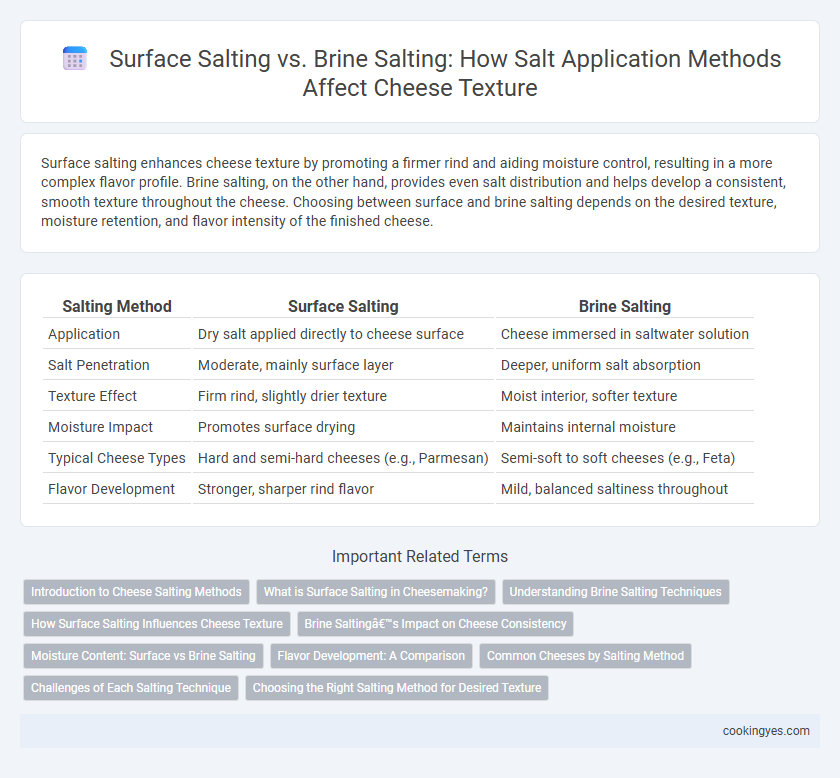Surface salting enhances cheese texture by promoting a firmer rind and aiding moisture control, resulting in a more complex flavor profile. Brine salting, on the other hand, provides even salt distribution and helps develop a consistent, smooth texture throughout the cheese. Choosing between surface and brine salting depends on the desired texture, moisture retention, and flavor intensity of the finished cheese.
Table of Comparison
| Salting Method | Surface Salting | Brine Salting |
|---|---|---|
| Application | Dry salt applied directly to cheese surface | Cheese immersed in saltwater solution |
| Salt Penetration | Moderate, mainly surface layer | Deeper, uniform salt absorption |
| Texture Effect | Firm rind, slightly drier texture | Moist interior, softer texture |
| Moisture Impact | Promotes surface drying | Maintains internal moisture |
| Typical Cheese Types | Hard and semi-hard cheeses (e.g., Parmesan) | Semi-soft to soft cheeses (e.g., Feta) |
| Flavor Development | Stronger, sharper rind flavor | Mild, balanced saltiness throughout |
Introduction to Cheese Salting Methods
Surface salting and brine salting are essential techniques that significantly influence cheese texture by controlling moisture and microbial activity. Surface salting involves directly applying dry salt to the cheese exterior, enhancing rind formation and creating a firmer texture. Brine salting, where cheese is immersed in a saltwater solution, allows for deeper salt penetration, resulting in a uniform texture and controlled aging process.
What is Surface Salting in Cheesemaking?
Surface salting in cheesemaking involves applying dry salt directly onto the cheese exterior to draw out moisture and form a protective rind, which influences the cheese's texture and flavor development. This method encourages a firm, occasionally slightly dry rind that helps regulate moisture loss and microbial growth during aging. Surface salting contrasts with brine salting, where cheese is submerged in a saltwater solution, affecting moisture content and texture more uniformly.
Understanding Brine Salting Techniques
Brine salting involves immersing cheese in a concentrated saltwater solution, which allows for uniform salt penetration and controlled moisture loss, enhancing texture and flavor development. The salt concentration, temperature, and duration of brining are critical variables that influence the cheese's rind formation and overall firmness. Compared to surface salting, brine salting provides a consistent and reproducible method for achieving desired cheese texture and microbial stability.
How Surface Salting Influences Cheese Texture
Surface salting directly impacts cheese texture by promoting the formation of a dry rind, which controls moisture loss and firmness. This method encourages a balanced salt diffusion that enhances curd structure, resulting in a more cohesive and elastic mouthfeel. The uneven salt penetration typical of surface salting also contributes to a varied texture gradient from the rind inward.
Brine Salting’s Impact on Cheese Consistency
Brine salting enhances cheese consistency by promoting even salt absorption and moisture retention, resulting in a uniformly firm texture. The saline solution penetrates the cheese matrix, influencing protein interactions and creating a smooth, cohesive body. This method is particularly effective for varieties like feta and mozzarella, where balanced moisture and salt distribution are critical for optimal flavor and mouthfeel.
Moisture Content: Surface vs Brine Salting
Surface salting involves applying dry salt directly to the cheese exterior, which gradually draws out moisture, resulting in a firmer texture and reduced surface moisture. In contrast, brine salting submerges cheese in a saltwater solution, allowing salt to penetrate uniformly and retain higher moisture content within the cheese body. Moisture content differences between these methods significantly influence cheese texture, with surface-salted cheeses typically dryer and crumblier compared to the juicier, softer texture of brine-salted cheeses.
Flavor Development: A Comparison
Surface salting allows for controlled salt absorption, enhancing the cheese's natural flavors and promoting a firmer rind texture, while brine salting facilitates deeper salt penetration, resulting in a more uniform flavor distribution and a moister interior. The osmotic effect in brine salting accelerates enzyme activity, intensifying flavor complexity over time, whereas surface salting primarily influences the cheese's exterior taste profile. Both methods impact moisture content differently, shaping the cheese's final texture and mature flavor characteristics.
Common Cheeses by Salting Method
Surface salting is commonly used for cheeses like Parmesan and Romano, creating a firm rind and enhancing granular textures, while brine salting is typical for Feta and Mozzarella, contributing to a moist, supple texture. Surface salt crystals draw moisture slowly, promoting rind formation and concentrated flavor development, whereas brine immersion ensures even salt distribution and maintains cheese hydration. Texture differences directly correlate with salting methods: surface salted cheeses exhibit a drier, crumbly consistency compared to the softer, creamier feel of brine salted varieties.
Challenges of Each Salting Technique
Surface salting can lead to uneven salt distribution, causing inconsistent texture and potential surface drying in cheese. Brine salting may result in excessive moisture uptake, which can weaken the cheese structure and alter its firmness. Both techniques require precise control of time and concentration to achieve optimal texture without compromising flavor or appearance.
Choosing the Right Salting Method for Desired Texture
Surface salting enhances cheese texture by creating a dry, firm rind that develops distinct flavor profiles, making it ideal for hard or semi-hard varieties like Parmesan and Asiago. Brine salting offers uniform moisture retention and a consistent, softer texture, preferred for cheeses such as feta and mozzarella. Selecting the appropriate salting method depends on desired moisture content, rind formation, and specific cheese characteristics for optimal texture development.
Surface Salting vs Brine Salting for Cheese Texture Infographic

 cookingyes.com
cookingyes.com